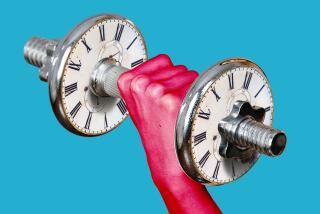Injury is no excuse
- Share via
WHEN David Scoggin discovered that the popping sensation he had felt while playing flag football was a complete tear of his Achilles tendon, he feared it meant being sidelined from workouts for a while.
As he stumbled around the gym a few times in a cast and crutches, his funk worsened. Not only did he have to hobble from machine to machine, he couldn’t even pick up a pair of dumbbells.
But after working out with a personal trainer, Scoggin, 32, found he could still do a lot, even cardiovascular exercises.
“The progress is so slow,” he says of getting his injured leg back to normal, but he’s making gains. Eight months after the accident, he hopes to be running soon. “Now,” he says, “I can see the light at the end of the tunnel.”
As most professional athletes know, an injury -- even a serious one -- doesn’t have to mean the end of a workout program. But even though many exercisers dread the loss of the strength, cardio and weight loss benefits they’ve achieved, some think they can’t or shouldn’t do any exercise while injured, and stop everything until the injury heals. Others let torn ligaments, snapped tendons or broken bones trigger a downward spiral of inactivity, even though their doctors and physical therapists may encourage them to exercise.
But maintaining an exercise regimen (if modified properly) has both physical and mental benefits -- and might ultimately enhance workout routines.
Sometimes low-impact exercises can even assist the healing, as is the case with some tears of the anterior cruciate ligament in the knee. For those injuries, “you want to maintain the range of motion, strength and function of the lower extremities,” says Dr. Peter Kurzweil, an orthopedic surgeon at the Southern California Center for Sports Medicine in Long Beach.
Although some people fear that sweating while wearing a cast will become uncomfortable and cause embarrassing odors, Kurzweil says that shouldn’t be a concern. A hair dryer can dry out damp gauze, and a cast can be changed if bacteria develop. Waterproof casts can even protect limbs underwater.
Even when a limb is incapacitated by a cast, the other arm or leg can be worked out solo. There’s a crossover effect in doing this, says Kurzweil; while exercising the good limb, the muscles of the other one get a bit of a workout too (one theory is that the dual effect is controlled by the central nervous system). And while some people try not to work the good limb too much, believing it will be disproportionate to the injured one, Kurzweil says that a sensible weight training and resistance routine won’t supersize an arm or leg.
Not even cardiovascular endurance has to be sacrificed with a lower-body injury, although the workout intensity may not be as high as going full throttle on a stair climber. An ergometer, which can be found in some gyms, is a kind of stationary bike for the upper body that uses the hands to pedal. Circuit training, going from station to station for resistance and core exercises, can keep the heart rate elevated. Pool workouts are also recommended for low-impact cardio. If some pressure can be put on the injured leg, pedaling a stationary bike is another option.
Scoggin, who lives in Malibu, began working with trainer Mark Myers several months ago to supplement physical therapy after his injury. In the beginning, Myers, at Equinox gym in Santa Monica, concentrated on getting Scoggin’s strength and range of motion back while avoiding any bouncing or jumping activity that might redamage his tendon.
At Myers’ direction, Scoggin did strength exercises for the upper part of the injured leg and, by exercising the uninjured leg, relied on the crossover effect to build strength in the lower part. An ergometer and circuit training gave him a cardio and upper-body workout, and stabilization exercises on an exercise ball helped him regain balance and alignment.
By slowly building intensity, Scoggin is now able to do half a calf raise on his injured leg and is starting to do some low-impact exercises. “I’m on the verge of a breakthrough,” he says.
Maintaining an exercise program can lessen muscle aches from crutches. It can also help prevent more stresses and strains as the body compensates for the out-of-commission part. When relying on one arm or leg, hip joints can become overused, shoulders worn out and knees sore.
There are also mental benefits to keeping up a workout, since exercise can help stave off depression as well as pounds.
Athletic coaches often keep injured athletes involved in training and competition, even if it’s performing simple tasks, so players can still feel part of the team. That principle can be applied to nonathletes as well, says Fabio Comana, certification and exam development manager for the American Council on Exercise.
“For anyone who has a passion about an activity and is completely removed from it,” he says, “there is some emotional duress you go through.” By staying involved on some level, “you can really streamline the return to activity.”
Some people have felt a renewed appreciation for exercise after they’re injured, says Zamia Cohn, a trainer at Equinox in Pasadena. “They realized, when they were not allowed to exercise, how much they missed it,” she says, “and how much better they feel when they do exercise.”
And, she points out, seeing an injured person working out can be a powerful motivator for the noninjured. “Most people will say it’s ridiculous not to come in when someone [else] has their foot in a cast or their arm in a sling. They look at them and say, ‘Wow, that’s dedication.’ ”
More to Read
Go beyond the scoreboard
Get the latest on L.A.'s teams in the daily Sports Report newsletter.
You may occasionally receive promotional content from the Los Angeles Times.










